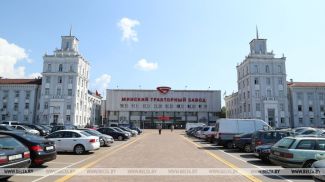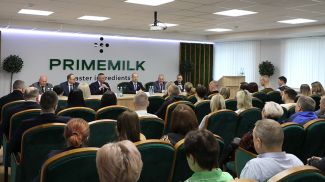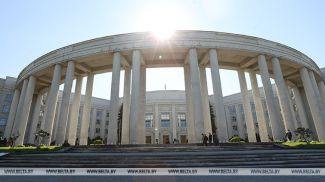MOSCOW, 25 May (BelTA) – Integration processes add a lot to the resumption of industrial growth in the Eurasian Economic Union (EAEU). The relevant statement was made by Sergei Sidorsky, Member of the Board (Minister) for Industry and Agribusiness of the Eurasian Economic Commission, during the Belarusian Industrial Forum in Minsk, the Commission's press service told BelTA.
Sergei Sidorsky was quoted as saying that the Eurasian Economic Union member states secured a positive industrial output growth rate in 2016. The Union's overall industrial output growth rate totaled 0.9%. Shipments delivered as part of manufacturing cooperation schemes rose by 1.2%. The last two years were the most dynamic ones for the Commission's industrial block, remarked Sergei Sidorsky. A number of industry-specific decisions were made in automobile engineering, agricultural machinery engineering, machine tool engineering, light industry, and metallurgy together with governments of the Eurasian Economic Union member states.
According to Sergei Sidorsky, introducing innovative instruments into the industrial cooperation of the Eurasian Economic Union member states is the key area of the Commission's efforts. Among other things efforts are exercised to create innovative and industrial infrastructure such as joint technology parks, technological platforms, industrial parks, economic zones, innovation centers, competence centers, and industrial clusters.
The Eurasian Economic Union member states will have to set up a Eurasian center for engineering machine tools. Its operation will help facilitate transition to a new technological paradigm. The draft constituent documents are supposed to go through the approval process soon. After that they will be forwarded for consideration of the Eurasian Economic Commission. “The Eurasian Economic Union imports 83% of the machine tools it needs. The figure is excessively large taking into account the potential our countries have. The Eurasian engineering center will have to radically change the situation,” stressed the official.
The Eurasian Economic Commission takes a serious approach to financing possible manufacturing cooperation projects involving all the EAEU countries. The Eurasian Development Bank will help with the economic expert evaluation of such projects as part of the working group, which was established at the beginning of the year. Work is in progress in association with the bank to determine criteria for greenlighting manufacturing cooperation projects and financing them. The new mechanism will help find and promote real manufacturing cooperation projects, noted the Eurasian Economic Commission minister. “We are already working with some of them but we need a lot more. We expect the Belarusian side to contribute heavily to it. We look forward to proposals from commercial entities,” said Sergei Sidorsky.
The Commission and the Eurasian Economic Union member states have already decided on forming Eurasian technological platforms. One of them provides for combining the satellites for the remote sensing of Earth into one constellation and creating an integrated Eurasian Economic Union system for providing space and geoinformation services. By 2020 the EAEU member states should be capable of jointly making and launching a new satellite with higher resolution capabilities. The relevant roadmap has been approved by the Eurasian Economic Commission's Advisory Committee for Industry and will be submitted for approval of the prime ministers of the EAEU member states soon.
Apart from that, the Commission together with the EAEU member states has made systemic decisions to set up a Eurasian network for technology transfer and for the digital transformation of economy. “Working out common approaches to the joint efforts to couple the Eurasian Economic Union and the Silk Road Economic Belt is important. It is a global and long-term project. It needs to be organized properly so that it could benefit the EAEU member states, including our industrial enterprises, as much as possible. Our mechanical engineering industry should get undeniable advantages in the logistic and industrial chains, which are being created within the framework of the Silk Road project, as well as in R&D products,” concluded Sergei Sidorsky.











